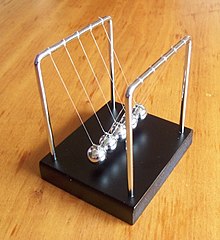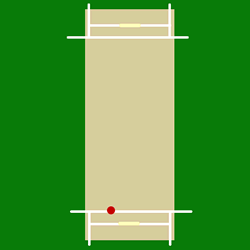
Leg spin is a type of spin bowling in cricket. A leg spinner bowls right-arm with a wrist spin action. The leg spinner's normal delivery causes the ball to spin from right to left when the ball bounces on the pitch. For a right-handed batter, that is away from the leg side, and this is where it gets the name leg break.
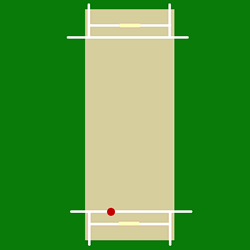
Off spin is a type of finger spin bowling in cricket. A bowler who uses this technique is called an off spinner. Off spinners are right-handed spin bowlers who use their fingers to spin the ball. Their normal delivery is an off break, which spins from left to right when the ball bounces on the pitch. For a right-handed batsman, this is from his off side to the leg side. The ball breaks away from the off side, hence the name 'off break'.

A toy or plaything is an object that is used primarily to provide entertainment. Simple examples include toy blocks, board games, and dolls. Toys are often designed for use by children, although many are designed specifically for adults and pets. Toys can provide utilitarian benefits, including physical exercise, cultural awareness, or academic education. Additionally, utilitarian objects, especially those which are no longer needed for their original purpose, can be used as toys. Examples include children building a fort with empty cereal boxes and tissue paper spools, or a toddler playing with a broken TV remote control. The term "toy" can also be used to refer to utilitarian objects purchased for enjoyment rather than need, or for expensive necessities for which a large fraction of the cost represents its ability to provide enjoyment to the owner, such as luxury cars, high-end motorcycles, gaming computers, and flagship smartphones.

An office is a space where the employees of an organization perform administrative work in order to support and realize the various goals of the organization. The word "office" may also denote a position within an organization with specific duties attached to it ; the latter is an earlier usage, office as place originally referring to the location of one's duty. In the adjective form, the term "office" may refer to business-related tasks. In law, a company or organization has offices in any place where it has an official presence, even if that presence consists of a storage silo, for example, instead of a more traditional establishment with a desk and chair. An office is also an architectural and design phenomenon, including small offices, such as a bench in the corner of a small business or a room in someone's home, entire floors of buildings, and massive buildings dedicated entirely to one company. In modern terms, an office is usually the location where white-collar workers carry out their functions.

Pet Rock is a collectible toy made in 1975 by advertising executive Gary Dahl. They were rocks packaged in custom cardboard boxes complete with ventilation holes and straw bedding imitating a pet carrier. The fad lasted about six months, ending after a short increase in sales during the Christmas season of December 1975. Although by February 1976 they were discounted due to lower sales, Dahl sold over one million Pet Rocks for $4 each, and became a millionaire.

Newton's cradle is a device, usually made of metal, that demonstrates the principles of conservation of momentum and conservation of energy in physics with swinging spheres. When one sphere at the end is lifted and released, it strikes the stationary spheres, compressing them and thereby transmitting a pressure wave through the stationary spheres, which creates a force that pushes the last sphere upward. The last sphere swings back and strikes the stationary spheres, repeating the effect in the opposite direction. The device is named after 17th-century English scientist Sir Isaac Newton and was designed by French scientist Edme Mariotte. It is also known as Newton's pendulum, Newton's balls, Newton's rocker or executive ball clicker.

A stress ball or hand exercise ball is a malleable toy, usually not more than 7 centimetres (2.8 in) in diameter. It is squeezed in the hand and manipulated by the fingers, ostensibly to relieve stress and muscle tension or to exercise the muscles of the hand.

Play is a range of intrinsically motivated activities done for recreational pleasure and enjoyment. Play is commonly associated with children and juvenile-level activities, but may be engaged in at any life stage, and among other higher-functioning animals as well, most notably mammals and birds.

Fidgeting is the act of moving about restlessly in a way that is not essential to ongoing tasks or events. Fidgeting may involve playing with one's fingers, hair, or personal objects. In this sense, it may be considered twiddling or fiddling. Fidgeting is commonly used as a label for unexplained or subconscious activities and postural movements that people perform while seated or standing idle.

The Newton is a series of personal digital assistants (PDAs) developed and marketed by Apple Computer, Inc. An early device in the PDA category, it was the first to feature handwriting recognition. Apple started developing the platform in 1987 and shipped the first devices in August 1993. Production officially ended on February 27, 1998. Newton devices ran on a proprietary operating system, Newton OS; examples include Apple's MessagePad series and the eMate 300, and other companies also released devices running on Newton OS. Most Newton devices were based on the ARM 610 RISC processor and all featured handwriting-based input.
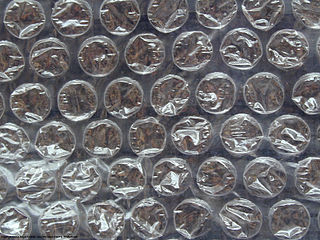
Bubble wrap is a pliable transparent plastic material used for packing fragile items. Regularly spaced, protruding air-filled hemispheres (bubbles) provide cushioning for fragile items.

Tony Fisher is a British puzzle designer who specialises in creating custom rotational puzzles. He is acknowledged by cubing enthusiasts as a pioneer in the creation of new puzzle designs and new manufacturing techniques. In 2017 the Guinness Book of World Records acknowledged Fisher as the creator of the world's largest Rubik's cube.

Fat Brain Toys is a United States manufacturer and retailer of educational toys and games. The company was founded by husband and wife, Mark and Karen Carson, from the basement of their home in 2002. It is headquartered in Elkhorn, Nebraska with a distribution center located in nearby Omaha, Nebraska. The company operates two retail storefronts, one in Omaha, Nebraska and another in Overland Park, Kansas. The company specializes in building toys, brainteasers, and multi-player games. They collect various statistics on their consumers and toys, such as the ages of recipients and a 'Toy Value Index' which they display at the lower end of the respective product's page. As of 2014, the company had 46 full-time employees. The staff expands to approximately 300 people during the holiday season.
Ketchapp SARL is a French video game publisher based in Paris, specializing in the mobile games market. Founded in 2014 by brothers Antoine and Michel Morcos, the company first came into the public eye later that year, through its port of the open-source game 2048. Ketchapp has been accused of cloning popular casual games by other developers. When Ketchapp was acquired by Ubisoft in September 2016, the company had more than 700 million downloads across their portfolio of games.

A fidget spinner is a toy that consists of a ball bearing in the center of a multi-lobed flat structure made from metal or plastic with metal weights in the lobes, designed to spin around its central axis. Fidget spinners became very prevalent trending toys in 2017.

The Toy Box is an American reality television show that debuted on April 7, 2017 on ABC. The show is about contestants as aspiring entrepreneurs, who present toy inventions first to a panel of toy industry professionals, then to a panel of child-judges. Only toys approved by the mentors are presented to the judges, "In the Toy Box," who select one toy to advance to the finals of each episode. The season's winning toy is produced and distributed by Mattel and sold exclusively at Toys "R" Us stores.

The Fidget Cube is a fidget toy designed by Matthew and Mark McLachlan, brothers and co-founders of the US design studio Antsy Labs. It has fidget tools on all sides: a toggle switch, gears, a rolling ball (marble), a joystick, a spinning disk, a worry stone, and five buttons. It may help users with ADHD focus. It can also help kids with autism and anxiety calm down or focus.
A squishy is a type of soft toy made of a specially formulated soft polyurethane foam, that slowly returns to its original shape after being squeezed. Squishies are manufactured into many different shapes and sizes, such as animals, fruits, and food items. They are often scented to match the object represented. The toy is also called kawaii squishy, kawaii meaning "cute" in Japanese.
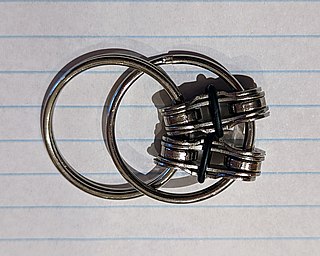
A fidget toy or fidget is typically a small object used for pleasant but purposeless activity with the hands. Some users believe these toys help them tolerate anxiety, frustration, agitation, boredom, and excitement. They are also commonly used by those with sensory difficulties.
